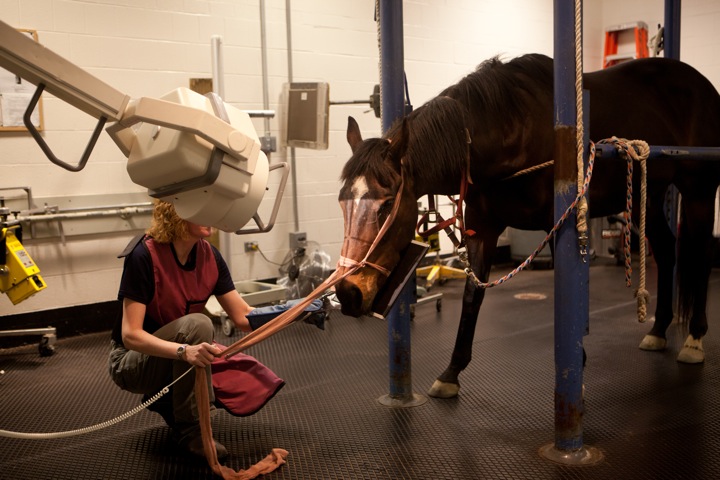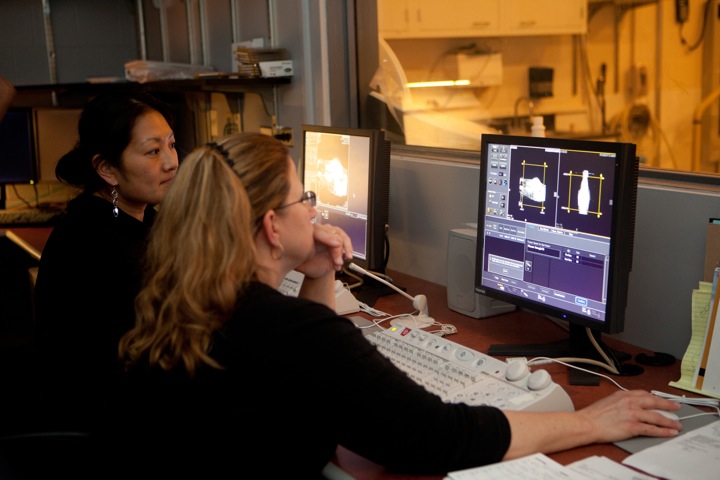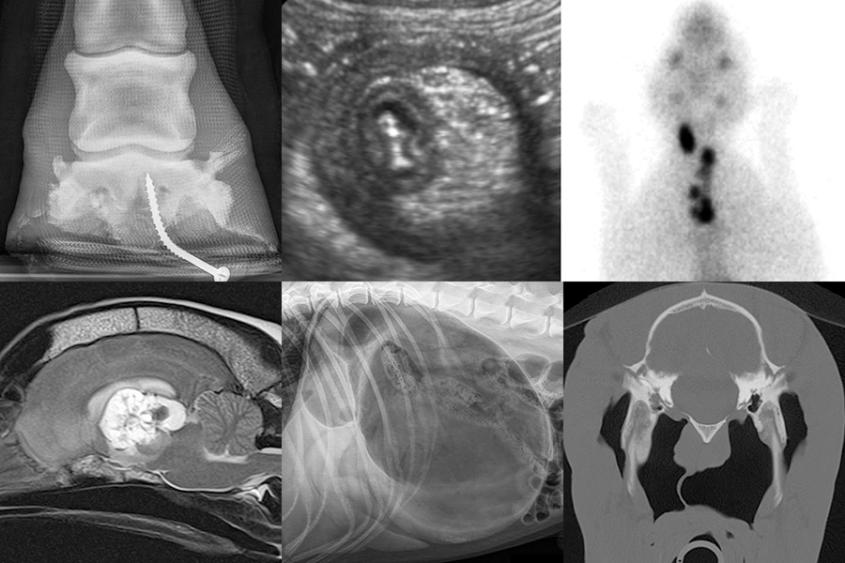 Your animal may need to be sedated or anesthetized to prevent movement during imaging. We do this when we anticipate that the procedure might be uncomfortable or painful, if the animal is anxious and whenever we expect that not holding perfectly still would defeat the procedure – motion is the bane of imaging! We work with your primary Cornell veterinarian to decide which sedative or anesthetic is most appropriate. Radiographs and ultrasound are often done awake, sometimes with a sedative, and occasionally when necessary we manually restrain the animal. We minimize manually holding animals for radiographs to limit our own exposure to x-radiation. Equine patients are always under general anesthesia for CT and MRI. Anesthesiologists are available to consult on all cases and ensure the safety of your animal.
Your animal may need to be sedated or anesthetized to prevent movement during imaging. We do this when we anticipate that the procedure might be uncomfortable or painful, if the animal is anxious and whenever we expect that not holding perfectly still would defeat the procedure – motion is the bane of imaging! We work with your primary Cornell veterinarian to decide which sedative or anesthetic is most appropriate. Radiographs and ultrasound are often done awake, sometimes with a sedative, and occasionally when necessary we manually restrain the animal. We minimize manually holding animals for radiographs to limit our own exposure to x-radiation. Equine patients are always under general anesthesia for CT and MRI. Anesthesiologists are available to consult on all cases and ensure the safety of your animal.
We interpret images and provide an oral report on the same day the study is obtained followed by a written report. For hospitalized animals, emergency imaging and interpretation is available 24/7/365 by residents and faculty on back-up.
Radiography
Agfa DX-G CR, Sound-Eklin Mark 1114cw DR
Commonly referred to as x-rays, radiographs are used widely in the horse for examination of distal limbs in the field. Our powerful in-hospital x-ray unit is capable of radiographing neck, chest and proximal limbs in the standing horse. Thicker body parts such as pelvis and spine can be radiographed in the anesthetized patient.
Ultrasound
Phillips EPIQ5 and Philips IU-22
Sonography is commonly to evaluate the soft tissues structures of the equine limb as well as the thorax and abdomen.
Computed Tomography (CT)
Toshiba Aquilion Large-Bore, 16-slice
CT scanning uses x-ray and sophisticated computer processing to render cross-sectional images of the body. General anesthesia is necessary for all equine examinations and is most commonly used to evaluate the head, teeth and distal limbs.
Magnetic resonance imaging (MRI)
Toshiba Vantage Atlas 1.5 Tesla
MRI examines body structures using the property of nuclear magnetic resonance to stimulate with radiofrequency energy the nuclei of hydrogen atoms aligned in a strong magnetic field and detect those signals for imaging. MRI provides excellent contrast between soft tissues that are otherwise indistinguishable by other means, which makes it especially useful in imaging the musculoskeletal (muscles, tendons, ligaments) systems, particularly the structures within the hoof capsule.
Nuclear Medicine
MIE Equine Scanner HR/Scintron VI-VME
In nuclear medicine imaging, radiopharmaceuticals are injected into the animal and a gamma camera detects the distribution of the isotope in the body. These examinations are used mainly for the diagnosis of bone lesions in the horse including osteoarthritis, stress fractures and occult causes of lameness. The radiation dose from the isotope is minimal and use is fully regulated by Environmental Health and Safety at Cornell and the New York State Health Department.
Digital Fluoroscopy
Hologic Insight FD Mini C-arm
The “C-arm” systems permit fluoroscopy in the operating room during surgery for real-time guidance in orthopedic repairs.
The ACVR sets standards for veterinary imaging professionals, certifies training programs and examines residents during and at the completion of a three-year, post-graduate program. Passing a written and oral examination leads to “board-certification” and is the credential required to practice as a veterinary radiologist. CUHA radiologists are board-certified and dedicated to service, education and research in veterinary imaging. We regularly have three or four residents training in the hospital.
The American College of Veterinary Radiology (ACVR) accredits Cornell’s residency program in Veterinary Imaging. This 3-year program generally enrolls one new candidate each July and provides specialty training in radiology, fluoroscopy, ultrasonography, nuclear medicine, computed tomography, and magnetic resonance imaging in small and large animals, and radioiodine treatment of hyperthyroidism in cats.
 The Imaging Service at the Cornell University Hospital for Animals takes pride in providing excellent patient care and customer service.
The Imaging Service at the Cornell University Hospital for Animals takes pride in providing excellent patient care and customer service.



 Your animal may need to be sedated or anesthetized to prevent movement during imaging. We do this when we anticipate that the procedure might be uncomfortable or painful, if the animal is anxious and whenever we expect that not holding perfectly still would defeat the procedure – motion is the bane of imaging! We work with your primary Cornell veterinarian to decide which sedative or anesthetic is most appropriate. Radiographs and ultrasound are often done awake, sometimes with a sedative, and occasionally when necessary we manually restrain the animal. We minimize manually holding animals for radiographs to limit our own exposure to x-radiation. Equine patients are always under general anesthesia for CT and MRI. Anesthesiologists are available to consult on all cases and ensure the safety of your animal.
Your animal may need to be sedated or anesthetized to prevent movement during imaging. We do this when we anticipate that the procedure might be uncomfortable or painful, if the animal is anxious and whenever we expect that not holding perfectly still would defeat the procedure – motion is the bane of imaging! We work with your primary Cornell veterinarian to decide which sedative or anesthetic is most appropriate. Radiographs and ultrasound are often done awake, sometimes with a sedative, and occasionally when necessary we manually restrain the animal. We minimize manually holding animals for radiographs to limit our own exposure to x-radiation. Equine patients are always under general anesthesia for CT and MRI. Anesthesiologists are available to consult on all cases and ensure the safety of your animal.